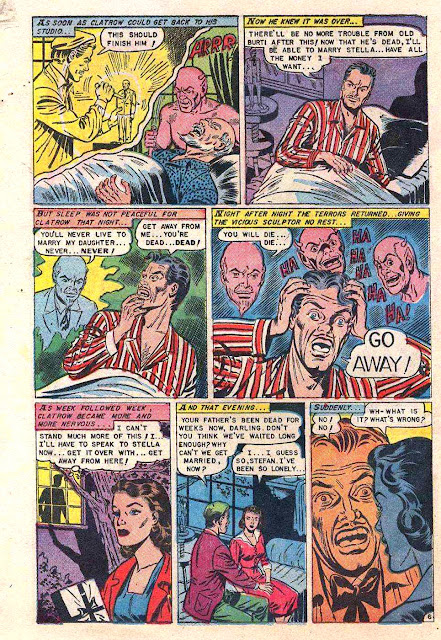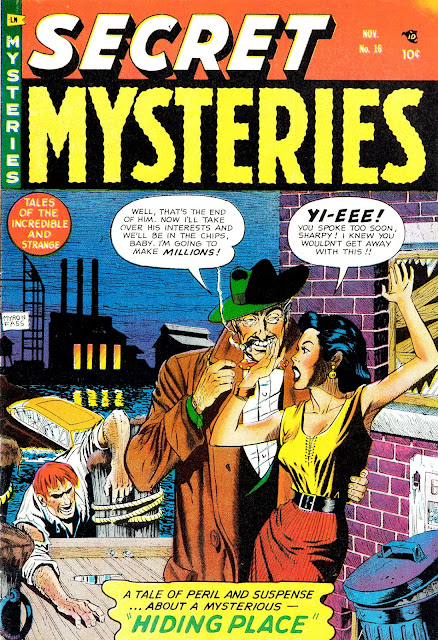Like many other cartoonists, Elias was influenced by the great Milton Caniff and he enjoyed a long and distinguished career working for Dell, Fiction House, Hillman, DC, Marvel and others. However, it was the work he produced for Harvey in the 1950's that established him as one of the premiere horror comics artists during the pre-Code era. In particular, his shocking covers for titles such as BLACK CAT MYSTERY COMICS, CHAMBER OF CHILLS and TOMB OF TERROR are synonymous with the type of illustrations that came under fire by Dr. Fredric Wertham and others as being unfit for the eyes of the youth of America.
The book is illustration-heavy with beautifully-reproduced color and black and white examples of his art from all periods, as well as many full-page reproductions of his original art. Included is a 25-page interview in which Elias candidly discusses his illustrious career.
I give "Light and Dark: The Art of Lee Elias" my highest recommendation
Lee Elias drew comics for several decades from the 1940s to the 1980s, first with Fiction House (Planet, then he became the #1 to-to cover artist for the Harvey Horror pre-code comics. His lush brushstrokes were equally matched by his fine pen line. Now at last, his body of work can be fully appreciated in this book devoted entirely to him. Includes many of his gory horror comics covers in full color and full page; original art, a lengthy interview from 1970 and a fine Appreciation by Michael J. Gilbert.
Finally, a long overdue book on one of the greatest artists that emerged to prominence during the horror comics scene of the 1950s. He did his first comic art work in 1943 for Fiction House illustrating such comics such as Planet (Space Rangers, Gale Allen), Wings (Captain Wings, Phantom Falcon) and Firehair. At DC around 1948-50, he drew some of the last issues of All Star Comics, co-created with Robert Kanigher the classic Flash villain The Fiddler, and worked on the last issues of The Flash and Green Lantern, also co-creating Star Sapphire.
In 1946 he started a long association with Harvey Comics as principal artist on the cute young Black Cat from the first issue of her own title, right through to when it became the horror title Black Cat Mystery, where his artwork truly excelled. He was often the cover artist and always a steady story artist for the Harvey Horror titles Tomb of Terror, Chamber of Chills, and Witches Tales!
Elias’s work for Harvey Comics rivaled the EC comics of the time and today many issues number amongst the most collectible of the Pre-Code horror era, particularly for their wild covers—acid or radiation in the face, rats eating human, vampires, rotting corpses, skeleton covers, devils, aliens, spacemen etc. Even his romance work at Harvey was steamy and his girls were pretty and appealing. DC later on in the sixties also had him doing romance work because of his ability to drawing appealing ladies. Leon Harvey even let him sign his work, a rarity for their creators in the fifties.
Several of the pre-code Harvey covers, both horror and romance, are accompanied by their original roughs and studies! These are really fun to see how he worked out both artwork and color! Many printed covers are also shown along the original artwork (thanks to Heritage Auctions).
Like many artists of the era, he was strongly influenced by one of the very greats, Milton Caniff. But Elias took that as a starting point and excelled beyond even Caniff.
He illustrated the well-known and excellent space comic strip Beyond Mars from 1952 to 1955. And continued working for Harvey. In the 1970s, he added Marvel (Marvel Fanfare and Epic Magazine) and Warren’s magazines to his portfolio. Upon retiring from comics, he became an instructor at the School of Visual Arts and the Joe Kubert School.
Sometimes overlooked and underappreciated, this fine new book will nicely address that issue!
There’s a massive 25 page interview with Lee Elias from 1970. This was originally printed in a low print run British fanzine of the time. Half of it then appeared in an early issue of Alter Ego magazine, #14. The full interview is printed here in its entirety for the first time since 1970.
The interview is fascinating. Elias was one of the top rated artists in the early 1950s; DC offered him top page rates but Harvey didn’t want to lose him and matched the rates, then only asking him to pencil! He’s also a man who was passionate about doing well-drawn comics, doing the best job possible whether for horror, Black Cat, romance, mystery adventure (his DC work included Strange Adventures, Unexpected, House of Mystery, Eclipso,Tommy Tomorrow, etc). He knew all the players, writers, editor and artists, and had forthright and quite respectable opinions about whoever he worked with. It like a black from the past, an interview with a still-in-demand artist about his work from 19460 to 1970, one in 1970. Carmine Infantino had just become DC’s Editorial Director at this time, which was quite a significant time for DC.
There are dozens of full page examples of Lee’s cover art, both printed and original art versions. The book also features examples of the thumbnail layouts by fellow Harvey Comics artist Warren Kremer which went into producing many of the covers.
And comic strips too!
Lee Elias was a master of the comic book medium. Equally adept with swathes of black ink applied with a sable brush as he was with fine line pen work drawn with a steel nib dip pen. His horror comic covers were so gruesome that several of them were shown in Dr. Frederick Wertham’s book The Seduction of the Innocent as examples of comics that were (supposedly) corrupting the youth of 1950s America.
























































